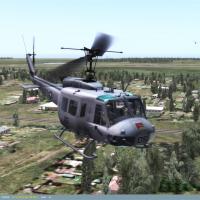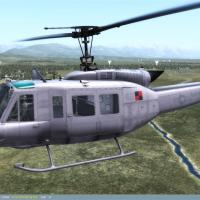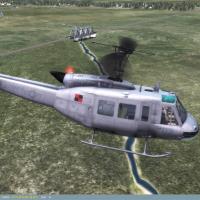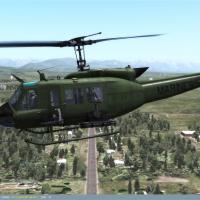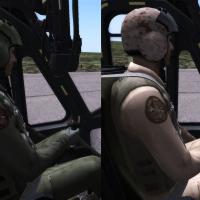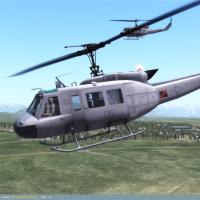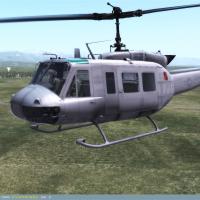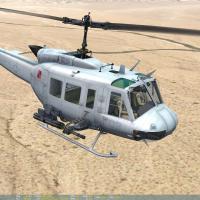About This File
Marine Light Helicopter Squadron (HML) 167 was commissioned in April 1968 in Vietnam, and flew the UH-1E in combat operations until June 1971, where it was the last Marine helicopter squadron in Vietnam. Of note, HML-167 was the first unit to drop a bomb from a helicopter, accomplished with the use of the Helicopter Trap Weapon (HTW). In June 1971, HML-167 returned stateside to MCAS New River, North Carolina, as part of the 2nd Marine Air Wing.
In 1972, HML-167 received the UH-1N Twin Huey, which it would fly until 2012 when the UH-1N was replaced by the UH-1Y Venom. In 1984, HML-167 received its first AH-1T Cobras and became a composite squadron of Cobras and Hueys. HML-167 was redesignated Marine Light Attack Helicopter Squadron (HMLA) 167 in April 1986, and as such designated as a permanent composite squadron of both Cobras and Hueys. HMLA-167 began upgrading to the AH-1W Super Cobra in late 1989.
Today the HMLA-167 "Warriors" fly the UH-1Y Venom and the AH-1W Super Cobra.
This is a collection of eleven UH-1 skins representing HMLA-167. The skins included are:
- TV-30 (1969 as HML-167)*
- TV-29 (1970 as HML-167)*
- "Santa 1" (1969 as HML-167)
- TV-30 (1982 as HML-167)
- TV-11 (1999)
- TV-03 (ca. 2003)
- TV-06 (ca. 2003)
- TV-04 (ca. 2005)
- TV-06 (ca. 2005)
- TV-05 (CO bird ca. 2008)
- TV-00 (UH-1Y CO bird ca. 2013)
* TV-29 and 30 (1969-70) are also included in my USMC Vietnam Skin Pack version 1.21 and later.
Each skin (1999 and later) has a "normal" version and a weathered version. Weathered skins have a bleached effect as if the aircraft were heavily exposed to the sun for months on end. Normal skins include pilots with green flightsuits, while weathered skins include pilots with desert flightsuits.
Note: this skin pack uses an EXE installer that creates common texture folders and an autoexec.cfg (if you already have one, you can make manual changes). I would like your feedback on this system; if it works I intend to apply it to my other skin packs.
Skinner's Philosophy:
Because the 3D models used for the aircrew utilize modern flight gear I have chosen to model the skins as "modern aircraft with nostalgic patterns", as opposed to actual historical skins.. The significance of this is that I have chosen to skin the aircrew in contemporary flight uniforms. I felt that this was more fitting in a setting that involves modern orders of battle, and is also less of an immersion-killer than seeing Vietnam era "uniforms" on clearly modern objects.
A note about the Crew Chief & Door Gunner:
Since enlisted US troops don't wear rank/rate insignia on flightsuits, their rank/rate is displayed on their nametag. Since there are no specific nametag textures for the crew chief/door gunner texture, I have added a nametag to the velcro on the chest armor (as is standard practice).
In choosing names for the texture, I opted for US servicemembers who received the Medal of Honor. CPL Jason Dunham was posthumously awarded the Medal of Honor in the Global War on Terror, and represents the Unites States Marine Corps in these skins. The following is his Medal of Honor citation:
For conspicuous gallantry and intrepidity at the risk of his life above and beyond the call of duty while serving as Rifle Squad Leader, 4th Platoon, Company K, Third Battalion, Seventh Marines (Reinforced), Regimental Combat Team 7, First Marine Division (Reinforced), on 14 April 2004. Corporal Dunham's squad was conducting a reconnaissance mission in the town of Karabilah, Iraq, when they heard rocket-propelled grenade and small arms fire erupt approximately two kilometers to the west. Corporal Dunham led his Combined Anti-Armor Team towards the engagement to provide fire support to their Battalion Commander's convoy, which had been ambushed as it was traveling to Camp Husaybah. As Corporal Dunham and his Marines advanced, they quickly began to receive enemy fire. Corporal Dunham ordered his squad to dismount their vehicles and led one of his fire teams on foot several blocks south of the ambushed convoy. Discovering seven Iraqi vehicles in a column attempting to depart, Corporal Dunham and his team stopped the vehicles to search them for weapons. As they approached the vehicles, an insurgent leaped out and attacked Corporal Dunham. Corporal Dunham wrestled the insurgent to the ground and in the ensuing struggle saw the insurgent release a grenade. Corporal Dunham immediately alerted his fellow Marines to the threat. Aware of the imminent danger and without hesitation, Corporal Dunham covered the grenade with his helmet and body, bearing the brunt of the explosion and shielding his Marines from the blast. In an ultimate and selfless act of bravery in which he was mortally wounded, he saved the lives of at least two fellow Marines. By his undaunted courage, intrepid fighting spirit, and unwavering devotion to duty, Corporal Dunham gallantly gave his life for his country, thereby reflecting great credit upon himself and upholding the highest traditions of the Marine Corps and the United States Naval Service.
CPL Dunham is also the namesake of the USS Jason Dunham (DDG-109), the Marine Corps Security Force barracks in Kings Bay, GA, and Crucible stations at both MCRD Parris Island and MCRD San Diego.
A note about Autoexec.cfg:
Rather than copying texture files to their respective livery folders, I prefer to use a series of common texture folders along with unique filenames. This allows a single instance of many of my common textures, and keeps the hard drive footprint to a minimum (especially nice if you run a SSD for your system drive).
The installer will add a series of folders to the DCS Texture path; if you do not have these folders created, then it is no problem. The autoexec.cfg included will automatically point to the Texture folder in your Saved Games\DCS folder, and regardless of whether you run the Open Alpha, Open Beta, or Release version of DCS, the path will always point to your Saved Games\DCS\Texture folder. Again, this saves space on your hard drive.
If you use your own Autoexec.cfg, then when prompted to overwrite you can click "no". This will create a file called autoexec.new, and you can manually make the updates as you like. Just don't modify the top line with the file date; this is used by the installer for version control. However, feel free to include it in your existing autoexec.cfg, so you don't get prompted to overwrite until there's another update to the autoexec.cfg.
If you inadvertently overwrite your autoexec.cfg, it is actually backed up as autoexec.old. Just open it and copy the appropriate information to the new file.
Special thanks to upuaut for assistance with the more "exotic" material names, as well as the assistance with custom rotor colors.
You are free to use any of the textures in other skins or projects as long as proper credit is provided in the readme file.
-Home Fries
What's New in Version 1.51
Released
- Added weathering to desert pilot nametags


